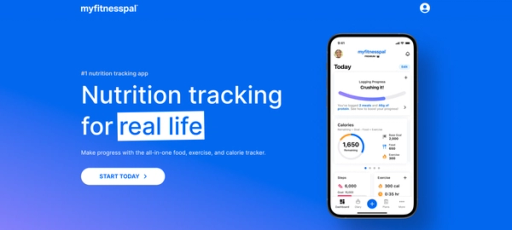
Have you ever wondered why reaching your fitness goals seems so hard? Maybe you want to shed some pounds, tone your body, or boost your overall health. No matter your objective, tracking your progress is key. Research shows that regular monitoring can double your chances of success. Calorie and macro tracking are especially helpful for those looking to lose weight or change their body composition. In this article, we pit Lifesum vs MyFitnessPal against each other to help you determine which is the best app to track macros and improve your fitness habits, leading to more effective and sustainable health progress.
Cal AI offers a valuable solution to help you achieve your fitness goals. Their calorie tracker makes it easy to start with calorie and macro tracking and provides personalized guidance based on your unique goals to help you get results.

Lifesum is a calorie-counting app designed to help you improve your diet, consume essential nutrients, and drink enough water. The app informs you about the foods you consume, promoting healthy eating for weight loss and maintenance. So you can use it to eat more nutritious foods or drop a few pounds.
Lifesum, as a calorie-counting app, also helps you calculate your calorie intake throughout the day and how much water you’ve had to know whether you’re well-hydrated. You can simply log your meals and snacks using Lifesum’s database of foods and drinks from thousands of different brands.
If you can’t find the item you’re looking for, you can use a barcode to add your own to the database. You can quickly bookmark frequently eaten meals to record them in your daily journal. You can also log your daily exercise routine for an accurate count of calories burned.
Lifesum also provides you with a “Life Score,” a number used to assess your health. The app asks 41 questions about your eating and exercise habits to generate this score. A higher score shows a better lifestyle. This is an excellent approach to evaluating your health-related behaviors to see if you’re on the right track or need to improve.
You can also use Lifesum if you don’t want calorie or macronutrient recommendations but just want cooking inspiration because the app offers many recipes.

MyFitnessPal is a fitness and nutrition app that serves as a diet and fitness tracker that allows you to:
It’s more than just a calorie-counting app, as it keeps track of your:
MyFitnessPal also allows you to track your exercise routine, which can help you stick to your fitness goals, such as working out more or performing more strength training. You can also log your daily water intake, which can help you stay hydrated. This app also offers a health-conscious community section. You can find and follow friends here, share your food and exercise diaries, and get accountability for your goals, inspiration, and motivation. This community is also a great place to get advice on maintaining a diet, losing weight, and forming healthy eating habits.MyFitnessPal contains educational articles with great exercises, recipes, and wellness tips. This health app is also connected to several popular smartphone apps and activity-tracking devices, such as:
These devices can monitor your activity levels, calorie burn, and more.
MyFitnessPal has several pros and cons. On the plus side, it has one of the largest food databases of any nutrition app, which makes it easy to find and log the foods you eat. The app also features a weight loss tracker to set goals and monitor your progress. It even provides notifications to remind you to log your food. The free version is also quite comprehensive. MyFitnessPal does have some downsides. Some users report that the barcode scanner doesn’t work at times. The free version has large and distracting ads, making it difficult to focus on your goals. The app also doesn’t have any habit-tracking features.

Lifesum and MyFitnessPal, as calorie-counting apps, share several similarities and functionalities that help people take control of their health. Here are some of the key similarities between the two:
Both Lifesum and MyFitnessPal provide food-tracking features where you can log your meals, drinks, and snacks throughout the day in your food diary. You can also view detailed nutritional information for each food item you log. This includes data on macronutrients like:
This can help you make informed dietary decisions.
Both apps have extensive databases of foods and drinks from thousands of different brands, making it easy and quick to log your foods and snacks. While Lifesum doesn’t specify the exact number of foods in its database, MyFitnessPal offers over 11 million items.
The apps also provide barcode scanners, which you can use to add your food items to the database if you can’t find them in the system. You can also save the favorite meals you consume frequently to add them to your daily food calendar.
Lifesum and MyFitnessPal enable users to plan their meals. With these apps, you can create your meal plan for the day, week, month, or even longer. This will help you stay organized and on track with your dietary goals.
Both apps allow you to log different types of exercises and physical activities. You can add in any strength training you do in the gym, and the apps’ system will estimate how many calories you’ll burn over a session.
The apps can also monitor your steps and record them throughout the day. They will then take your steps and turn them into calorie reduction. This can help you know how many calories you’ve burned.
While these two apps have similarities, they have unique features and approaches. MyFitnessPal is a better choice for athletes and fitness professionals, while Lifesum is a better alternative for sustainable living.
MyFitnessPal can be your best app if you’re looking for a health and fitness app that offers many free features. The app only charges for a few extra features compared to Lifesum, which does not include meal planning or recipes in its free version.
If your needs are about sustainable living and lifestyle over fitness, Lifesum can be an excellent option. It has everything you need to make little dietary adjustments that produce excellent outcomes.
MyFitnessPal should also be your app of choice if you want an effective calorie counter that allows flexibility and easy food tracking. While Lifesum offers a structured approach to dieting, it could be too restrictive for some users.
Suppose you’re also interested in getting in shape and raising your fitness levels. In that case, MyFitnessPal can be a great choice as it provides a variety of routines, from circuits to HIIT and muscle training. Lifesum allows you to track your exercise, but it doesn’t give any workout plans. Although both applications include communities of users on the same track, MyFitnessPal may be a better choice if this is your consideration. You will have a better chance of finding people experiencing the same difficulties as you because of the app’s larger user base.

Food Database
Lifesum has an extensive food library with plenty of verified options, noted with a blue check mark.
Tracking Capabilities
• Calories
• Protein
• Carbs
• Fats
• Sodium & Potassium
• Exercise activity
• Body weight
• Circumference measures
• Habits
Calorie Recommendations
Lifesum’s calorie recommendations tend to be too low because it doesn’t account for user activity levels.
Level of Customization
Premium users can customize their nutritional targets, choose meal plans, add habit goals, and more.
Educational Opportunities
Lifesum isn’t intended to be an educational app, but it does help users learn about the quality of their food.
Coaching
Although users can’t work with a coach in the app, it provides reports you can share with your coach.
Recipe Database
Lifesum has an extensive recipe library, even for those following specific diets.
Exercise Calories
Premium users can track their exercise calories and decide what to do with that information (e.g., ignore it or add it to their daily total).
Price
Lifesum has three payment options:
• Monthly – $9.99, billed every month
• Quarterly – $24.99, billed every three months ($8.33/month)
• Annual plan – $49.99, billed annually ($4.17/month)
Reviews
On Google Play, Lifesum has a rating of 4.3 out of 5 stars, with over 333,000 reviews, and 4.7 out of 5 stars on the App Store, with 133,000+ reviews.
Food Database
MyFitnessPal has an extensive food library, but there is a fair degree of inaccuracy, given the large number of user entries.
Tracking Capabilities
• Calories
• Protein
• Carbs
• Fats
• Vitamins A & C, Calcium, Iron, Sodium, and Potassium
• Water intake
• Exercise activity
• Steps taken
• Circumference measures
• Progress Pictures
Calorie Recommendations
MyFitnessPal’s recommendations are slightly more accurate but still low.
Level of Customization
MyFitnessPal also allows for the customization of nutritional targets but not much else.
Educational Opportunities
MyFitnessPal only provides nutrition information that you’d find on a nutrition label.
Coaching
The only option for users is to share their food diary with their coach.
Recipe Database
MyFitnessPal allows users to discover recipes based on hashtags or categories.
Exercise Calories
MyFitnessPal allows you to track exercise calories and decide what to do with them (e.g., add them back or ignore them) in the free version.
Price
MyFitnessPal costs $79.99 for a whole year or $19.99 monthly. There is also a one-month free trial right now.
Reviews
The app currently has a rating of 4.1 out of 5 stars on Google Play, with over 2.6 million reviews, and 4.7 out of 5 on the App Store, with 1.7+ million reviews.
Lifesum has an extensive food database. Many foods have verified nutritional data, identifiable with a blue checkmark. Users can also add their foods and meals to the database, which can introduce inaccuracies. To ensure accuracy when logging food, stick to verified entries and avoid others as much as possible.MyFitnessPal has an extensive food database with millions of foods, ingredients, and meals with nutritional information. One of the things that made MyFitnessPal explode in popularity back in the day was the ability for users to add to the food database. Nevertheless, this feature means there are bound to be some inaccurate entries.
While the database is still valuable for those experienced enough to spot inaccuracies, it can make tracking calories and macronutrients more frustrating.
The Winner: Lifesum.
Although MyFitnessPal has a much more extensive food database, Lifesum is the winner because of its abundant database of verified foods.
Lifesum allows users to track their:
MyFitnessPal allows users to track calories, macronutrients, vitamins, and minerals (including vitamins A and C, calcium, iron, sodium, and potassium), water intake, exercise activity, steps taken, body measurements (including body weight and body fat percentage, neck, waist, and hip circumferences), and progress pictures.
The free version doesn’t have the barcode scanner, so non-premium users must manually input foods more often.
The Winner: MyFitnessPal.
Both apps have similar tracking capabilities (especially the free versions), but MyFitnessPal tracks more micronutrients (vitamins and minerals) than Lifesum and allows users to upload progress pictures.
Lifesum’s calorie recommendations are too low. They fail to factor the user’s activity level into their calorie calculations. These inaccurate calorie recommendations also negatively affect the protein recommendations. Targets that are too low will cause muscle loss, extreme hunger, and low energy, so users of this app must adjust their targets.
MyFitnessPal’s calorie recommendations tend to be low, but not as low as Lifesum, because MFP factors in the user’s activity level.I still recommend adjusting your calorie and macronutrient targets yourself or with the help of a coach rather than relying on MFP’s recommendations. The only downside of setting your macronutrient targets with MFP is that the free version allows you to adjust them only to the nearest 5%. You must pay for the premium version to set specific protein, carb, and fat goals.
The Winner: MyFitnessPal.
Although neither app provides accurate calorie and macronutrient recommendations, MyFitnessPal tends to be more precise.
Lifesum allows users to customize their calories and macronutrients with a premium plan. Users can also customize their experience by adjusting their preferred loss rate, following a meal plan (keto, paleo, clean eating, etc.), and selecting habits goals.MyFitnessPal’s free version allows users to customize their calorie and macro targets to some extent, but the app’s premium version is required to customize nutritional targets completely.
The Winner: Lifesum.
Although MyFitnessPal is better as a free option because users can adjust their calories and macronutrients without paying for a premium plan, I’m declaring Lifesum the winner because there are more opportunities to personalize your experience beyond calories and macros.
Lifesum isn’t designed to be an educational app, but it provides ratings, nutritional information, and pros and cons for each verified food in its database. This helps users learn about the quality and quantity of foods they eat.MyFitnessPal is similar to Lifesum in that it isn’t designed to provide education and is simply a tool to help users keep track of their intake. MyFitnessPal offers nutritional information for each food, but it does not give the user context about the quality of the food.
The Winner: Lifesum.
Both apps provide users with basic nutritional information, helping them better understand the composition of each food and how it affects their diet and energy intake. Nevertheless, Lifesum takes this a step further by giving the user context about the quality of the food using a rating and a list of benefits and drawbacks.
Lifesum has no options for users to work with a coach inside the app. Nevertheless, the app does provide daily, weekly, and monthly reports that you can send to your coach so they can advise you on how to manipulate your targets to stay on track with your goal.MyFitnessPal doesn’t offer ‘in-house’ coaching services, but users can turn on diary sharing and provide their coaches with some access to their food journal. That said, the visibility isn’t great, and the coach doesn’t have options to alter targets inside the app.
The Winner: Tie.
I’m declaring it a tie because the reports from Lifesum are just as helpful as the direct access that MFP provides to coaches.
Lifesum has a ton of healthy recipes for users, including recipes for various diets and specific food preferences. The recipes are complete with nutritional information.MyFitnessPal’s Recipe Discovery feature allows users to find recipes based on category (e.g., keto diet) or hashtag (e.g., immune support). Premium users can import one or more servings of a recipe into their diary, which is convenient and reduces the need for manual input. Nevertheless, it’s worth noting that this method is only effective if you follow the original recipe strictly.
The Winner: Tie.
The recipe database category is among the most difficult to pick a winner as both apps offer unique benefits. On the one hand, Lifesum has thousands of great recipes, many of which are easy to make.
On the other hand, MyFitnessPal has a more sophisticated search engine that allows users to filter by category or hashtag. MyFitnessPal is better because it offers plenty of fantastic recipes in its free version. That said, the Lifesum recipes are worth paying for a premium subscription.
Lifesum allows users to track the number of calories burned during exercise. Nevertheless, the app defaults to adding these burned calories to your daily target. You can turn off this feature, but only with the premium version.MyFitnessPal can also track the calories burned through exercise and, by default, add them back into your intake. Nevertheless, you can turn off this feature if you want to lose weight, as it makes achieving a calorie deficit more difficult.
The Winner: MyFitnessPal.
Both apps have similar capabilities in this category, with the ability to turn off this feature, but you can do it for free with MFP, whereas you have to pay for premium with Lifesum.
Lifesum has a free version, but you must pay for the premium version to access all its features. There are three payment options for the premium version:
MyFitnessPal has a free version, but you must pay for the premium to access all its features (including the barcode scanner). Premium costs $79.99 for a year ($6.66/month) or $19.99 monthly. A one-month free trial is also available, giving you plenty of time to test the app before committing.
The Winner: Lifesum.
Lifesum is the better option because it’s cheaper overall and has capabilities similar (if not more) to MyFitnessPal.
Lifesum has a rating of 4.3 out of 5 stars on Google Play, with over 333,000 reviews, and 4.7 out of 5 stars on the App Store, with 133,000+ reviews.MyFitnessPal currently has a rating of 4.1 out of 5 stars on Google Play, with over 2.6 million reviews, and 4.7 out of 5 on the App Store, with 1.7+ million reviews. Strangely, the rating fell significantly in the last few months, with many recent users leaving negative reviews. How the rating will change in the next six to twelve months is anybody’s guess.
The Winner: Tie.
While MyFitnessPal might seem like the clear winner here, given the similar ratings with far more reviews, the fact that it’s dropped to 4.1 stars so rapidly is alarming.
Lifesum is ideal for people who:
MyFitnessPal is helpful for:
Cal AI transforms calorie tracking with cutting-edge AI technology. Just snap a photo of your meal, and we'll do the rest. Our app combines your phone's depth sensor with advanced AI models to analyze food volume, identify ingredients, and instantly calculate calories, protein, carbs, and fat content.
With 90% accuracy on visible foods and multiple tracking options like barcode scanning, food label recognition, and manual description for complex items like smoothies, we've made nutrition tracking effortless. Gone are the days of tedious manual logging calorie tracking apps.
Whether scanning a full meal or a quick snack, Cal AI gives you accurate nutritional information in under 15 seconds. Plus, our AI learns from your feedback, continuously improving its accuracy. Stay on track with personalized insights and smart reminders. Cal AI makes achieving your fitness goals simpler than ever.
Track your calories with your camera with Cal AI's AI calorie tracker today!